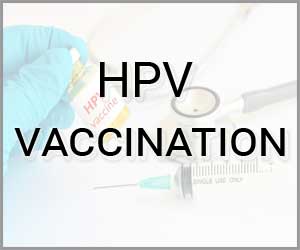- Home
- Editorial
- News
- Practice Guidelines
- Anesthesiology Guidelines
- Cancer Guidelines
- Cardiac Sciences Guidelines
- Critical Care Guidelines
- Dentistry Guidelines
- Dermatology Guidelines
- Diabetes and Endo Guidelines
- Diagnostics Guidelines
- ENT Guidelines
- Featured Practice Guidelines
- Gastroenterology Guidelines
- Geriatrics Guidelines
- Medicine Guidelines
- Nephrology Guidelines
- Neurosciences Guidelines
- Obs and Gynae Guidelines
- Ophthalmology Guidelines
- Orthopaedics Guidelines
- Paediatrics Guidelines
- Psychiatry Guidelines
- Pulmonology Guidelines
- Radiology Guidelines
- Surgery Guidelines
- Urology Guidelines
Extending HPV vaccination ages to produce relatively small health benefits

In the United States, the routine age for human papillomavirus (HPV) vaccination is 11 to 12 years, with catch-up vaccination through age 26 years for women and 21 years for men. U.S. vaccination policy on use of the 9-valent HPV vaccine in adult women and men is being reviewed.
A health economic model suggests that extending the U.S. human papillomavirus (HPV) vaccination program to include women and men through age 45 would produce relatively small health benefits compared with the current immunization program. Findings from a modelling study are published in Annals of Internal Medicine.
In October 2018, the U.S. Food and Drug Administration expanded the approved age range for use of the 9-valent HPV vaccine from 9 through 26 years to 9 through 45 in women and men. Among other considerations for policy, recommendations are the potential for population-level health benefits relative to the increased costs.
Researchers used publicly available data to develop a model that would evaluate the added population-level effectiveness and cost-effectiveness of extending the current U.S. HPV vaccination program. Different strategies were compared with routine vaccination of all adolescents at age 11-12 years and vaccination through age 26 for women and 21 for men who were not vaccinated previously.
The model showed that the current vaccination strategy in the U.S. will substantially reduce HPV-associated diseases and is cost-saving, whereas vaccinating mid-adult women and men through age 45 years is predicted to produce small additional reductions in HPV-associated diseases and result in substantially higher cost-effectiveness ratios than the current recommendations. These findings suggest that policies extending HPV vaccination programs to include middle-aged adults may produce relatively small population benefit. Results were most sensitive to assumptions about natural immunity and progression rates after infection, historical vaccination coverage, and vaccine efficacy.
The researchers concluded that the current HPV vaccination program is predicted to be cost saving. Extending vaccination to older ages is predicted to produce small additional health benefits and result in substantially higher incremental cost-effectiveness ratios than the current recommendation.
For further reference log on to :
http://annals.org/aim/article/doi/10.7326/M19-1182

Disclaimer: This site is primarily intended for healthcare professionals. Any content/information on this website does not replace the advice of medical and/or health professionals and should not be construed as medical/diagnostic advice/endorsement or prescription. Use of this site is subject to our terms of use, privacy policy, advertisement policy. © 2020 Minerva Medical Treatment Pvt Ltd